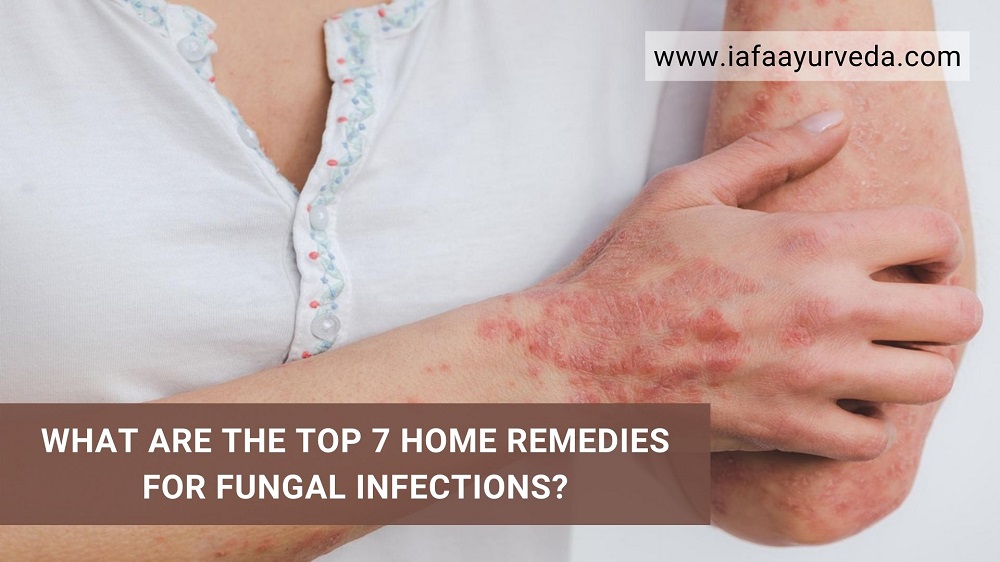Mycosis is another term used for a fungus infection. Although most fungi are safe for humans, some of them can cause illness in certain circumstances. Because fungi multiply by producing spores that may be picked up by direct touch or breathed, they are most likely to impact your nails, skin, or lungs.
Skin fungus can manifest itself in any portion of the body, from an oral rush to foot fungus. The infection can produce redness, irritation, and dermal crumbling. To date, the consequences of fungal infection have gone unnoticed, and conventional treatments have shown to be ineffectual and irritating to the skin.
The infection can be annoying and uncomfortable, it’s typically not serious. And if one knows how to treat fungal infections at home, it becomes manageable. To make your recovery journey simpler and full of nature’s goodness, we’ve listed the seven best home remedies for fungal infection for you!
Ayurvedic Treatment of Fungal Infections
The greatest and most successful cure for every disease is in Ayurveda. Treatment for the fundamental cause, advice from highly qualified experts, and specific food and lifestyle recommendations provide a secure and natural healing from fungal infection. Healthy and disease-free living may be achieved by following a healthy diet and lifestyle. Different Panchakarma treatments and medications and cures can be provided based on the patient’s symptoms, Prakriti, Doshas involved, and seasons.
Home Remedies for Fungal Infections
Antibiotics and other treatments are mostly ineffective against many of the fungi that cause these diseases. Fungal infections are notoriously difficult to treat, and they can take a long time to heal entirely. Although over-the-counter medications and antifungal ointments are widely available, most fungal skin infections may be treated at home. Some of the most effective home remedies for fungal infection healing that are both natural and effective and will provide you with fantastic results are described below.
1) Tea Tree Oil
This is an antibacterial and antifungal ingredient that works quickly. Combine this herbal oil with a carrier oil such as coconut or olive oil. When the mixture is ready, apply it to the diseased region with caution. Tea tree oil is known to promote the formation of new cells, therefore it has potential. Make sure you just apply the mixture to the injured region of your skin, since a sloppy application might spread the fungus.
2) Honey
Raw honey is well-known for its medicinal benefits. Honey that has not been pasteurized works wonderfully for fighting germs and fungi since it includes hydrogen peroxide, an antiseptic. You should apply a spoonful of honey to the diseased area to get rid of it. Not only is it vital to obtain a suitable cure, but how the cure is applied influences the speed of healing.
3) Turmeric
Turmeric is renowned as the “wonder spice” because of its numerous health benefits. It is a powerful antifungal that controls and hinders the growth of fungi. The chemical curcumin is the active element in turmeric, and it is responsible for all of the advantages it brings to the body’s normal functioning. According to several studies, they have antifungal and anti-microbial features in addition to anti-fungal qualities.
4) Mulethi Powder
This plant is used to cure different types of fungal illnesses, although it is most commonly used to treat ringworm infestations. Several research has been undertaken and the findings have shown that it has anti-microbial, anti-fungal, and anti-inflammatory qualities, making it an important plant for treating fungal infections and other skin problems.
5) Garlic
Garlic is another powerful antifungal and antibacterial plant. Those who consume it regularly have a lower risk of acquiring fungal infections. Crush a handful of garlic cloves and combine with olive oil to make a paste. Apply for 30 minutes to the affected area. Candida, Ringworm, Torulopsis, Trichophyton, and Cryptococcus may all be treated with garlic.
6) Neem Leaf
Neem is thought to be a particularly efficient fungal infection remedy. Some researchers even go so far as to say that it is the greatest cure. Its antifungal and natural detoxifying qualities can rid the skin of major infections and dermatophytes. Neem leaves must be cooked before being used on the skin. Neem water can also be utilized in the bath for a stronger effect.
7) Apply Aloe Vera
Aloe vera is a popular skin-soothing plant. It’s one of the greatest natural home remedies for skin problems and a fantastic healer for a variety of fungal diseases. Aloe vera destroys fungi and germs due to its antiseptic properties. It can also stop the yeast from growing.
Conclusion
Fungal infections become quite general. The itchy, scaly red skin can induce a lot of discomfort. If not treated promptly, the hives can spread and irritate the skin even more. Contact us to consult Dr. Sahil Gupta at the Institute of Applied Food Allergy®. He uses safe and effective natural herbs to treat all sorts of allergies successfully and organically.




